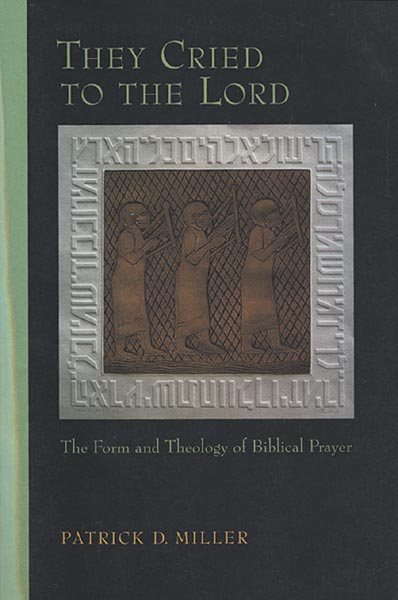I am currently working through Patrick D. Miller's They Cried To the Lord: The Form and Theology of Biblical Prayer (Minneapolis: Fortress Press, 1994) and am finding it to be dense, yet profitable. This is a scholarly work dedicated to James L. Mays, whom I have come to greatly appreciate for his work on the Psalms (see here and here).
AUDIENCE
The audience for which Miller wrote is suggested by Michael Welker in his endorsement on the back cover--"This volume will become a standard work not only for exegetes but also for both practical and systematic theologians, for pastors, and for anyone interested in understanding the foundations of piety." Having found numerous references to this work in commentaries and studies on the Psalms, I believe that Welker's statement has been amply validated.
AUDIENCE
The audience for which Miller wrote is suggested by Michael Welker in his endorsement on the back cover--"This volume will become a standard work not only for exegetes but also for both practical and systematic theologians, for pastors, and for anyone interested in understanding the foundations of piety." Having found numerous references to this work in commentaries and studies on the Psalms, I believe that Welker's statement has been amply validated.
The opening paragraph of Miller's Preface not only identifies the source from which these studies originated, but also grounds this work in a very practical setting: the classroom. Miller writes,
This study of biblical prayer arises form teaching seminary students, pastors, and lay people about the Psalms and, more broadly, about prayer in Scripture. All of these groups have taught me as I have taught them and thus have helped to shape this book in large and small ways. (xv)
So, we have here a book on the theology of prayer which was developed and cultivated in the crucible of the classroom in conversation with a variety of practitioners. This sounds promising!
THEME
This book is introduced with the thought-provoking declaration that "No single practice more clearly defines a religion than the act of praying" (1). Furthermore, by arguing that belief is shaped by prayer, Miller contends for the necessary interdependence and essential unity of prayer and the theological task. He continues,
THEME
This book is introduced with the thought-provoking declaration that "No single practice more clearly defines a religion than the act of praying" (1). Furthermore, by arguing that belief is shaped by prayer, Miller contends for the necessary interdependence and essential unity of prayer and the theological task. He continues,
"So prayer and theology exist in relation to each other in a correcting circle, the one learning from the other and correcting the other. Religious faith seeks not to think one way and to pray another but to come before God in a manner that is consistent with what we believe and profess about God and God's way and to think about God in a way that is shaped by the experience of actual encounter in prayer. Learning to pray teaches about God" (1).
AIM
The stated aim of this book is "to look fairly comprehensively and broadly at biblical prayer," yet this volume is not to be taken as "a theology of prayer in general," but rather "a theology of biblical prayer" (2).
The stated aim of this book is "to look fairly comprehensively and broadly at biblical prayer," yet this volume is not to be taken as "a theology of prayer in general," but rather "a theology of biblical prayer" (2).
"WHAT OTHER GREAT NATION HAS A GOD SO NEAR TO US?"*
Chapter 1, "Israel's Neighbors at Prayer," was an introduction to new territory for me, yet I found it fascinating to see the many parallels and contrasts between the examples of Mesopotamian prayers provided. One lesson that stood out to me (and which is promised to be dealt with more fully later on in the book) was the note that whereas the prayers of Israel's neighbors typically
Chapter 1, "Israel's Neighbors at Prayer," was an introduction to new territory for me, yet I found it fascinating to see the many parallels and contrasts between the examples of Mesopotamian prayers provided. One lesson that stood out to me (and which is promised to be dealt with more fully later on in the book) was the note that whereas the prayers of Israel's neighbors typically
Miller concludes this chapter with the following observation:
The commonality that does exist between Israel's prayers and those of its neighbors suggests structures and modes of prayer that are not precisely identical but sufficiently related that we can assume there is something universal here, that it is in the shared and common history that we learn what God seeks in prayer, that the modes receive a confirmation in part because they seem to be common human ways belonging to the creatureliness of every human being and the imperfect and partial effort on the part of the creature to communicate with the divine. (31)I didn't expect to find so much in common although it is clear that, beyond the polytheistic and monotheistic differences between Israel and her early neighbors, the openness and freedom which Israel and all of her children enjoy in prayer is unmistakable.
____________________
* NOTE - I love connecting the dots between books, authors and history. Here is a hint to the significance of the title chosen for the Festschrift in honor of Patrick Miller: Brent A. Strawn and Nancy R. Bowen (eds.), A God So Near: Essays on Old Testament Theology in Honor of Patrick D. Miller (Eisenbrauns, 2003).


No comments:
Post a Comment